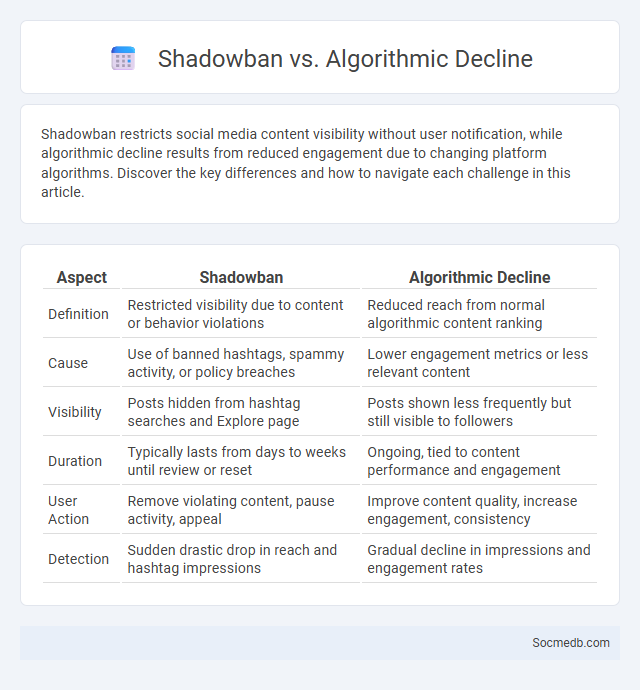
Photo illustration: Shadowban vs Algorithmic decline
Shadowban restricts social media content visibility without user notification, while algorithmic decline results from reduced engagement due to changing platform algorithms. Discover the key differences and how to navigate each challenge in this article.
Table of Comparison
| Aspect | Shadowban | Algorithmic Decline |
|---|---|---|
| Definition | Restricted visibility due to content or behavior violations | Reduced reach from normal algorithmic content ranking |
| Cause | Use of banned hashtags, spammy activity, or policy breaches | Lower engagement metrics or less relevant content |
| Visibility | Posts hidden from hashtag searches and Explore page | Posts shown less frequently but still visible to followers |
| Duration | Typically lasts from days to weeks until review or reset | Ongoing, tied to content performance and engagement |
| User Action | Remove violating content, pause activity, appeal | Improve content quality, increase engagement, consistency |
| Detection | Sudden drastic drop in reach and hashtag impressions | Gradual decline in impressions and engagement rates |
Understanding Shadowban: Definition and Mechanisms
Shadowban is a covert restriction on your social media account visibility, limiting content reach without notifying you. Platforms like Instagram and Twitter employ complex algorithms to detect and reduce exposure of posts deemed spammy or violating guidelines. Understanding these mechanisms helps you adjust content strategy to maintain engagement and avoid penalties.
What is Algorithmic Decline? Key Indicators
Algorithmic decline refers to the reduced effectiveness of social media algorithms in delivering relevant content to users, often resulting in decreased engagement and reach. Key indicators include a noticeable drop in user interaction metrics such as likes, shares, comments, and view duration, alongside declining organic reach and slower growth in follower counts. Monitoring changes in click-through rates, audience retention, and content performance over time also signals potential algorithmic adjustments affecting visibility.
Demystifying Algorithmic Ranking: How It Works
Social media platforms use complex algorithmic ranking systems that prioritize content based on user engagement, relevance, and personalization metrics. These algorithms analyze interactions such as likes, shares, comments, and viewing time to determine the visibility of posts in a user's feed. Understanding these mechanisms helps users and marketers optimize content strategies for increased reach and engagement.
Shadowban vs Algorithmic Decline: Spotting the Differences
Shadowban restricts a user's content visibility without notification, causing a sudden drop in engagement and reach across platforms like Instagram and TikTok. Algorithmic decline occurs gradually, linked to changes in platform algorithms that prioritize different content types or user behavior patterns. Identifying shadowban involves sudden, drastic drops in impressions and hashtag invisibility, while algorithmic decline presents as steady decreases influenced by evolving content relevance and audience interaction.
Common Causes of Shadowbanning
Shadowbanning on social media commonly results from posting content that violates platform guidelines, including spreading misinformation or using prohibited language. User behavior such as excessive posting, repetitive comments, or spam-like activity can trigger automated filters designed to limit visibility. Engagement patterns that resemble bot activity or coordinated inauthentic behavior also frequently lead to shadowbans.
Signs Your Content Faces Algorithmic Decline
You may experience algorithmic decline if your social media content sees a sudden drop in engagement, reach, or impressions despite consistent posting. A decrease in follower interaction such as likes, comments, and shares indicates platforms may deprioritize your content due to relevance or quality signals. Monitoring analytics tools for diminishing reach rates and engagement metrics helps identify if algorithm changes are affecting your content visibility.
How Algorithmic Ranking Influences Content Visibility
Algorithmic ranking determines the visibility of your content by analyzing factors such as engagement rate, relevance, and timeliness, prioritizing posts that generate meaningful interactions. Social media platforms use machine learning models to tailor feeds based on individual user behavior, increasing the chances that the most engaging and relevant content appears first. Understanding these ranking signals can help you optimize your posts for maximum exposure and improved audience reach.
Diagnosing Shadowban: Steps and Tools
Diagnosing a shadowban on social media requires analyzing sudden drops in engagement metrics such as likes, comments, and reach using tools like ShadowbanTester or Triberr. You can also search hashtags from your posts in incognito mode to check if your content appears in feeds, indicating visibility restrictions. Monitoring account analytics consistently helps identify behavioral patterns and confirms whether shadowban algorithms are limiting your audience access.
Strategies to Recover from Algorithmic Decline
You can recover from social media algorithmic decline by diversifying your content formats, such as incorporating videos, stories, and live streams to boost engagement. Consistently analyzing platform insights helps identify what types of posts resonate most with your audience, allowing you to refine your content strategy effectively. Engaging authentically with followers through comments, direct messages, and community features increases visibility and fosters stronger connections, improving your overall algorithm ranking.
Best Practices to Optimize for Algorithmic Ranking
Optimizing social media content for algorithmic ranking requires consistent posting schedules, high engagement rates, and relevant hashtags tailored to target audiences. Prioritize creating authentic, interactive content such as polls, Q&A sessions, and live videos to boost user interaction metrics favored by platforms like Instagram, TikTok, and Facebook. Analyzing performance insights and adapting strategies based on algorithm changes ensures sustained visibility and growth across social media channels.
 socmedb.com
socmedb.com